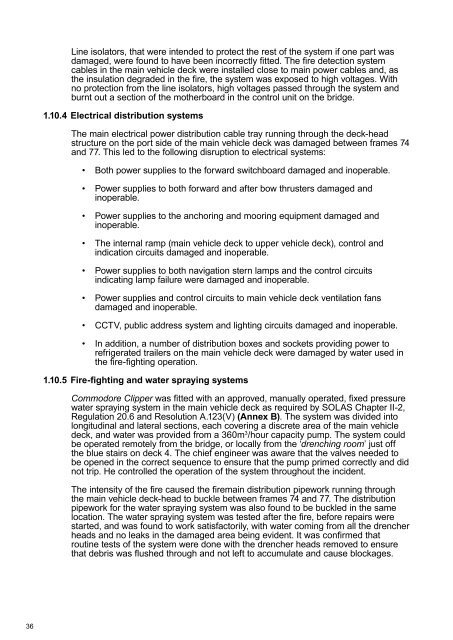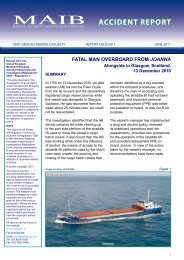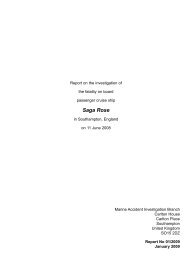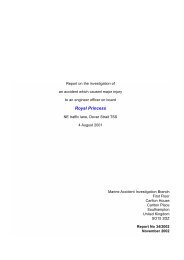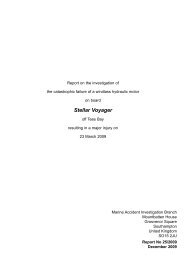Commodore Clipper - Marine Accident Investigation Branch
Commodore Clipper - Marine Accident Investigation Branch
Commodore Clipper - Marine Accident Investigation Branch
You also want an ePaper? Increase the reach of your titles
YUMPU automatically turns print PDFs into web optimized ePapers that Google loves.
36<br />
Line isolators, that were intended to protect the rest of the system if one part was<br />
damaged, were found to have been incorrectly fitted. The fire detection system<br />
cables in the main vehicle deck were installed close to main power cables and, as<br />
the insulation degraded in the fire, the system was exposed to high voltages. With<br />
no protection from the line isolators, high voltages passed through the system and<br />
burnt out a section of the motherboard in the control unit on the bridge.<br />
1.10.4 Electrical distribution systems<br />
The main electrical power distribution cable tray running through the deck-head<br />
structure on the port side of the main vehicle deck was damaged between frames 74<br />
and 77. This led to the following disruption to electrical systems:<br />
• Both power supplies to the forward switchboard damaged and inoperable.<br />
• Power supplies to both forward and after bow thrusters damaged and<br />
inoperable.<br />
• Power supplies to the anchoring and mooring equipment damaged and<br />
inoperable.<br />
• The internal ramp (main vehicle deck to upper vehicle deck), control and<br />
indication circuits damaged and inoperable.<br />
• Power supplies to both navigation stern lamps and the control circuits<br />
indicating lamp failure were damaged and inoperable.<br />
• Power supplies and control circuits to main vehicle deck ventilation fans<br />
damaged and inoperable.<br />
• CCTV, public address system and lighting circuits damaged and inoperable.<br />
• In addition, a number of distribution boxes and sockets providing power to<br />
refrigerated trailers on the main vehicle deck were damaged by water used in<br />
the fire-fighting operation.<br />
1.10.5 Fire-fighting and water spraying systems<br />
<strong>Commodore</strong> <strong>Clipper</strong> was fitted with an approved, manually operated, fixed pressure<br />
water spraying system in the main vehicle deck as required by SOLAS Chapter II-2,<br />
Regulation 20.6 and Resolution A.123(V) (Annex B). The system was divided into<br />
longitudinal and lateral sections, each covering a discrete area of the main vehicle<br />
deck, and water was provided from a 360m 3 /hour capacity pump. The system could<br />
be operated remotely from the bridge, or locally from the ‘drenching room’ just off<br />
the blue stairs on deck 4. The chief engineer was aware that the valves needed to<br />
be opened in the correct sequence to ensure that the pump primed correctly and did<br />
not trip. He controlled the operation of the system throughout the incident.<br />
The intensity of the fire caused the firemain distribution pipework running through<br />
the main vehicle deck-head to buckle between frames 74 and 77. The distribution<br />
pipework for the water spraying system was also found to be buckled in the same<br />
location. The water spraying system was tested after the fire, before repairs were<br />
started, and was found to work satisfactorily, with water coming from all the drencher<br />
heads and no leaks in the damaged area being evident. It was confirmed that<br />
routine tests of the system were done with the drencher heads removed to ensure<br />
that debris was flushed through and not left to accumulate and cause blockages.


